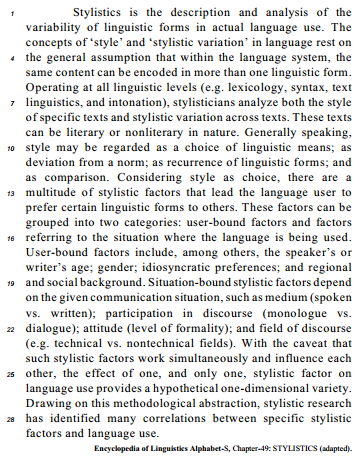Questões de Concurso Público EBC 2011 para Analista, Tradução - Língua Inglesa
Foram encontradas 70 questões

In the sentence

In the sentence

Each of the following items offers a suggestion for a translation into Portuguese of some excerpts of the text above. If the proposed translation is accurate and acceptable label the item C (certo). Otherwise, label it E (errado).

Each of the following items offers a suggestion for a translation into Portuguese of some excerpts of the text above. If the proposed translation is accurate and acceptable label the item C (certo). Otherwise, label it E (errado).

Each of the following items offers a suggestion for a translation into Portuguese of some excerpts of the text above. If the proposed translation is accurate and acceptable label the item C (certo). Otherwise, label it E (errado).

In the text, the word “bias” (R.5)

In the text, the word “bias” (R.5)
Considering translation and some of the notions it envolves, judge
the following items.
Acceptations which go beyond the primary meaning of a linguistic expression can be said to be connotative.
Considering translation and some of the notions it envolves, judge
the following items.
Equivalence is a much debated term in translation studies for want of a widely accepted definition.
Considering translation and some of the notions it envolves, judge
the following items.
Context can be defined as extra-textual features which determine the translation of a linguistic expression or a whole text.
Considering translation and some of the notions it envolves, judge
the following items.
Concerning translation, faithfulness and adequacy can be used interchangeably as they both refer to the same translation strategy.
Considering translation and some of the notions it envolves, judge
the following items.
Formal correspondence is a concept which refers to the equivalence between the original text and the translated test in terms of register.
Considering translation and some of the notions it envolves, judge
the following items.
Translation should be understood as communication and the search for an exact equivalence between the languages involved in the process.

Based on the text above, judge the items below.

Based on the text above, judge the items below.

Based on the text above, judge the items below.
into Portuguese of passages in English.
The Mayan Indians lived in Mexico for thousands of years before the Spanish arrived in the 1500s. The Maya were an intelligent, culturally rich people whose achievements were many. They had farms, beautiful palaces, and cities with many buildings. The Mayan people knew a lot about nature and the world around them. This knowledge helped them to live a better life than most people of that time, because they could use it to make their lives more comfortable and rewarding. Knowledge about tools and farming, for instance, made their work easier and more productive.
An appropriate and correct translation of this passage would be: Os índios maias viveram no México há milhares de anos, mesmo antes da chegada dos espanhóis em 1500. Os maias eram um povo inteligente, culturalmente rico, cujas conquistas foram muitas. Eles tinham fazendas, belos palácios e cidades com muitos edifícios. O povo maia sabia muito sobre a natureza e o mundo ao seu redor. Esse conhecimento os ajudou a viver uma vida melhor do que a maioria das pessoas daquele tempo, porque poderiam usá-lo para tornar suas vidas mais confortáveis e gratificantes. Conhecimento sobre ferramentas e agricultura, além disso, fizeram o seu trabalho mais fácil e mais produtivo.
into Portuguese of passages in English.
In technical translation, the effect on the readers matters more than the actual words or the syntactic layout and the translator will probably follow an idiomatic or a free translation.
The following text, adapted from the website www.bbc.co.uk can be said to be a descriptive text: “There is a surprising truth about how we all see the world. You may think a rose is red, the sky is blue and the grass is green, but it now seems that the colours you see may not always be the same as the colours I see. Your age, sex and even mood can affect how you experience colours".
